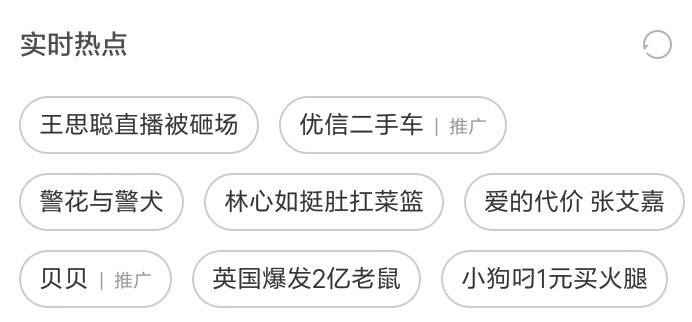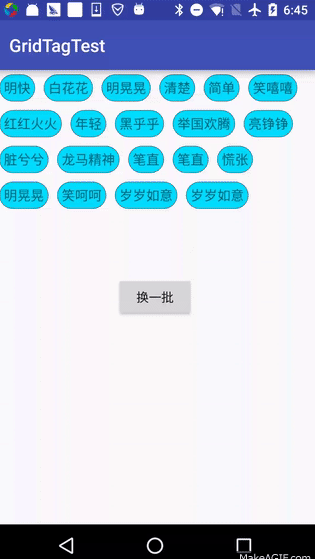
- Android获取SD卡路径及SDCard内存的方法
- Android TextView字体颜色设置方法小结
- Android微信图片浏览框架设计
- Android AsyncTask源码分析
- Android中WebView图片实现自适应的方法
- Android开机自启动程序详解
- Android用HandlerThread模拟AsyncTask功能(ThreadTask)
- Android中获得手机屏幕大小实现代码
- Android控制闪光灯的方法(打开与关闭)
- Android实现Service获取当前位置(GPS+基站)的方法
- Android基站定位原理及实现代码
- Android实现桌面悬浮窗、蒙板效果实例代码
- Android学习笔记--Activity中使用Intent传值示例代码
- 全面总结Android中线程的异步处理方式
- 谷歌被屏蔽后如何搭建安卓环境
- [Java4Android]15_面向对象基础(四)
- Android编程之菜单实现方法
- 解析libcurl在android下的移植、编译与测试
- Android SQLite3多线程操作问题研究总结
- 详解Android中通过Intent类实现组件间调用的方法
- Android DrawerLayout带有侧滑功能的布局类(2)
- Android采用File形式保存与读取数据的方法
- Android开发之SQLite的使用方法
- Android文件下载进度条的实现代码
- Android系统自带样式 (android:theme)
- Android代码实现图片和文字上下布局
- 一款超酷的Android自定义加载控件
- android 权限大全 分享
- Android如何通过手机获取验证码来完成注册功能
- Android动画效果之自定义ViewGroup添加布局动画(五)
Android中标签容器控件的实例详解
前言
在一些APP中我们可以看到一些存放标签的容器控件,和我们平时使用的一些布局方式有些不同,它们一般都可以自动适应屏幕的宽度进行布局,根据对自定义控件的一些理解,今天写一个简单的标签容器控件,给大家参考学习。
下面这个是我在手机上截取的一个实例,是在MIUI8系统上截取的

这个是我实现的效果图

原理介绍
根据对整个控件的效果分析,大致可以将控件分别从以下这几个角度进行分析:
1.首先涉及到自定义的ViewGroup,因为现有的控件没法满足我们的布局效果,就涉及到要重写onMeasure和onLayout,这里需要注意的问题是自定义View的时候,我们需要考虑到View的Padding属性,而在自定义ViewGroup中我们需要在onLayout中考虑Child控件的margin属性否则子类设置这个属性将会失效。整个View的绘制流程是这样的:
最顶层的ViewRoot执行performTraversals然后分别开始对各个View进行层级的测量、布局、绘制,整个流程是一层一层进行的,也就是说父视图测量时会调用子视图的测量方法,子视图调孙视图方法,一直测量到叶子节点,performTraversals这个函数翻译过来很直白,执行遍历,就说明了这种层级关系。
2.该控件形式上和ListView的形式比较相近,所以在这里我也模仿ListView的Adapter模式实现了对控件内容的操作,这里对ListView的setAdapter和Adapter的notifyDataSetChanged方法做个简单的解释:
在ListView调用setAdapter后,ListView会去注册一个Observer对象到这个adapter上,然后当我们在改变设置到adapter上的数据发改变时,我们会调用adapter的notifyDataSetChanged方法,这个方法就会通知所有监听了该Adapter数据改变时的Observer对象,这就是典型的监听者模式,这时由于ListView中的内部成员对象监听了该事件,就可以知道数据源发生了改变,我们需要对真个控件重新进行绘制了,下面来一些相关的源码。
Adapter的notifyDataSetChanged
public void notifyDataSetChanged() {
mDataSetObservable.notifyChanged();
}
ListView的setAdapter方法
@Override
public void setAdapter(ListAdapter adapter) {
/**
*每次设置新的适配的时候,如果现在有的话会做一个解除监听的操作
*/
if (mAdapter != null && mDataSetObserver != null) {
mAdapter.unregisterDataSetObserver(mDataSetObserver);
}
resetList();
mRecycler.clear();
/** 省略部分代码..... */
if (mAdapter != null) {
mAreAllItemsSelectable = mAdapter.areAllItemsEnabled();
mOldItemCount = mItemCount;
mItemCount = mAdapter.getCount();
checkFocus();
/**
*在这里对adapter设置了监听,
*使用的是AdapterDataSetObserver类的对象,该对象定义在ListView的父类AdapterView中
*/
mDataSetObserver = new AdapterDataSetObserver();
mAdapter.registerDataSetObserver(mDataSetObserver);
/** 省略 */
} else {
/** 省略 */
}
requestLayout();
}
AdapterView中的内部类AdapterDataSetObserver
class AdapterDataSetObserver extends DataSetObserver {
private Parcelable mInstanceState = null;
@Override
public void onChanged() {
/* ***代码略*** */
checkFocus();
requestLayout();
}
@Override
public void onInvalidated() {
/* ***代码略*** */
checkFocus();
requestLayout();
}
public void clearSavedState() {
mInstanceState = null;
}
}
一段伪代码表示
ListView{
Observer observer{
onChange(){
change;
}
}
setAdapter(Adapter adapter){
adapter.register(observer);
}
}
Adapter{
List<Observer> mObservable;
register(observer){
mObservable.add(observer);
}
notifyDataSetChanged(){
for(i-->mObserverable.size()){
mObserverable.get(i).onChange
}
}
}
实现过程
获取ViewItem的接口
package humoursz.gridtag.test.adapter;
import android.view.View;
import java.util.List;
/**
* Created by zhangzhiquan on 2016/7/19.
*/
public interface GrideTagBaseAdapter {
List<View> getViews();
}
抽象适配器AbsGridTagsAdapter
package humoursz.gridtag.test.adapter;
import android.database.DataSetObservable;
import android.database.DataSetObserver;
/**
* Created by zhangzhiquan on 2016/7/19.
*/
public abstract class AbsGridTagsAdapter implements GrideTagBaseAdapter {
DataSetObservable mObservable = new DataSetObservable();
public void notification(){
mObservable.notifyChanged();
}
public void registerObserve(DataSetObserver observer){
mObservable.registerObserver(observer);
}
public void unregisterObserve(DataSetObserver observer){
mObservable.unregisterObserver(observer);
}
}
此效果中的需要的适配器,实现了getView接口,主要是模仿了ListView的BaseAdapter
package humoursz.gridtag.test.adapter;
import android.content.Context;
import android.view.LayoutInflater;
import android.view.View;
import android.widget.TextView;
import java.util.ArrayList;
import java.util.List;
import humoursz.gridtag.test.R;
import humoursz.gridtag.test.util.UIUtil;
import humoursz.gridtag.test.widget.GridTagView;
/**
* Created by zhangzhiquan on 2016/7/19.
*/
public class MyGridTagAdapter extends AbsGridTagsAdapter {
private Context mContext;
private List<String> mTags;
public MyGridTagAdapter(Context context, List<String> tags) {
mContext = context;
mTags = tags;
}
@Override
public List<View> getViews() {
List<View> list = new ArrayList<>();
for (int i = 0; i < mTags.size(); i++) {
TextView tv = (TextView) LayoutInflater.from(mContext)
.inflate(R.layout.grid_tag_item_text, null);
tv.setText(mTags.get(i));
GridTagView.LayoutParams lp = new GridTagView
.LayoutParams(GridTagView.LayoutParams.WRAP_CONTENT
,GridTagView.LayoutParams.WRAP_CONTENT);
lp.margin(UIUtil.dp2px(mContext, 5));
tv.setLayoutParams(lp);
list.add(tv);
}
return list;
}
}
最后是主角GridTagsView控件
package humoursz.gridtag.test.widget;
import android.content.Context;
import android.database.DataSetObserver;
import android.util.AttributeSet;
import android.util.Log;
import android.view.View;
import android.view.ViewGroup;
import java.util.List;
import humoursz.gridtag.test.adapter.AbsGridTagsAdapter;
/**
* Created by zhangzhiquan on 2016/7/18.
*/
public class GridTagView extends ViewGroup {
private int mLines = 1;
private int mWidthSize = 0;
private AbsGridTagsAdapter mAdapter;
private GTObserver mObserver = new GTObserver();
public GridTagView(Context context) {
this(context, null);
}
public GridTagView(Context context, AttributeSet attrs) {
this(context, attrs, 0);
}
public GridTagView(Context context, AttributeSet attrs, int defStyleAttr) {
super(context, attrs, defStyleAttr);
}
public void setAdapter(AbsGridTagsAdapter adapter) {
if (mAdapter != null) {
mAdapter.unregisterObserve(mObserver);
}
mAdapter = adapter;
mAdapter.registerObserve(mObserver);
mAdapter.notification();
}
@Override
protected void onMeasure(int widthMeasureSpec, int heightMeasureSpec) {
int widthSize = MeasureSpec.getSize(widthMeasureSpec);
int heightSize = MeasureSpec.getSize(heightMeasureSpec);
int curWidthSize = 0;
int childHeight = 0;
mLines = 1;
for (int i = 0; i < getChildCount(); ++i) {
View child = getChildAt(i);
measureChild(child, widthMeasureSpec, heightMeasureSpec);
curWidthSize += getChildRealWidthSize(child);
if (curWidthSize > widthSize) {
/**
* 计算一共需要多少行,用于计算控件的高度
* 计算方法是,如果当前控件放下后宽度超过
* 容器本身的高度,就放到下一行
*/
curWidthSize = getChildRealWidthSize(child);
mLines++;
}
if (childHeight == 0) {
/**
* 在第一次计算时拿到字视图的高度作为计算基础
*/
childHeight = getChildRealHeightSize(child);
}
}
mWidthSize = widthSize;
setMeasuredDimension(widthSize, childHeight == 0 ? heightSize : childHeight * mLines);
}
@Override
protected void onLayout(boolean changed, int l, int t, int r, int b) {
if (getChildCount() == 0)
return;
int childCount = getChildCount();
LayoutParams lp = getChildLayoutParams(getChildAt(0));
/**
* 初始的左边界在自身的padding left和child的margin后
* 初始的上边界原理相同
*/
int left = getPaddingLeft() + lp.leftMargin;
int top = getPaddingTop() + lp.topMargin;
int curLeft = left;
for (int i = 0; i < childCount; ++i) {
View child = getChildAt(i);
int right = curLeft + getChildRealWidthSize(child);
/**
* 计算如果放下当前试图后整个一行到右侧的距离
* 如果超过控件宽那就放到下一行,并且左边距还原,上边距等于下一行的开始
*/
if (right > mWidthSize) {
top += getChildRealHeightSize(child);
curLeft = left;
}
child.layout(curLeft, top, curLeft + child.getMeasuredWidth(), top + child.getMeasuredHeight());
/**
* 下一个控件的左边开始距离是上一个控件的右边
*/
curLeft += getChildRealWidthSize(child);
}
}
/**
* 获取childView实际占用宽度
* @param child
* @return 控件实际占用的宽度,需要算上margin否则margin不生效
*/
private int getChildRealWidthSize(View child) {
LayoutParams lp = getChildLayoutParams(child);
int size = child.getMeasuredWidth() + lp.leftMargin + lp.rightMargin;
return size;
}
/**
* 获取childView实际占用高度
* @param child
* @return 实际占用高度需要考虑上下margin
*/
private int getChildRealHeightSize(View child) {
LayoutParams lp = getChildLayoutParams(child);
int size = child.getMeasuredHeight() + lp.topMargin + lp.bottomMargin;
return size;
}
/**
* 获取LayoutParams属性
* @param child
* @return
*/
private LayoutParams getChildLayoutParams(View child) {
LayoutParams lp;
if (child.getLayoutParams() instanceof LayoutParams) {
lp = (LayoutParams) child.getLayoutParams();
} else {
lp = (LayoutParams) generateLayoutParams(child.getLayoutParams());
}
return lp;
}
@Override
public ViewGroup.LayoutParams generateLayoutParams(AttributeSet attr) {
return new LayoutParams(getContext(), attr);
}
@Override
protected ViewGroup.LayoutParams generateLayoutParams(ViewGroup.LayoutParams p) {
return new LayoutParams(p);
}
public static class LayoutParams extends MarginLayoutParams {
public LayoutParams(Context c, AttributeSet attrs) {
super(c, attrs);
}
public LayoutParams(int width, int height) {
super(width, height);
}
public LayoutParams(MarginLayoutParams source) {
super(source);
}
public LayoutParams(ViewGroup.LayoutParams source) {
super(source);
}
public void marginLeft(int left) {
this.leftMargin = left;
}
public void marginRight(int r) {
this.rightMargin = r;
}
public void marginTop(int t) {
this.topMargin = t;
}
public void marginBottom(int b) {
this.bottomMargin = b;
}
public void margin(int m){
this.leftMargin = m;
this.rightMargin = m;
this.topMargin = m;
this.bottomMargin = m;
}
}
private class GTObserver extends DataSetObserver {
@Override
public void onChanged() {
removeAllViews();
List<View> list = mAdapter.getViews();
for (int i = 0; i < list.size(); i++) {
addView(list.get(i));
}
}
@Override
public void onInvalidated() {
Log.d("Mrz","fd");
}
}
}
MainActivity
package humoursz.gridtag.test;
import android.support.v7.app.AppCompatActivity;
import android.os.Bundle;
import android.view.View;
import java.util.List;
import humoursz.gridtag.test.adapter.MyGridTagAdapter;
import humoursz.gridtag.test.util.ListUtil;
import humoursz.gridtag.test.widget.GridTagView;
public class MainActivity extends AppCompatActivity {
MyGridTagAdapter adapter;
GridTagView mGridTag;
List<String> mList;
@Override
protected void onCreate(Bundle savedInstanceState) {
super.onCreate(savedInstanceState);
setContentView(R.layout.activity_main);
mGridTag = (GridTagView)findViewById(R.id.grid_tags);
mList = ListUtil.getGridTagsList(20);
adapter = new MyGridTagAdapter(this,mList);
mGridTag.setAdapter(adapter);
}
public void onClick(View v){
mList.removeAll(mList);
mList.addAll(ListUtil.getGridTagsList(20));
adapter.notification();
}
}
XML 文件
<?xml version="1.0" encoding="utf-8"?>
<RelativeLayout xmlns:android="http://schemas.android.com/apk/res/android"
xmlns:tools="http://schemas.android.com/tools"
android:layout_width="match_parent"
android:layout_height="match_parent"
tools:context="humoursz.gridtag.test.MainActivity">
<humoursz.gridtag.test.widget.GridTagView
android:id="@+id/grid_tags"
android:layout_width="match_parent"
android:layout_height="wrap_content">
</humoursz.gridtag.test.widget.GridTagView>
<Button
android:layout_centerInParent="true"
android:layout_width="wrap_content"
android:layout_height="wrap_content"
android:onClick="onClick"
android:text="换一批"/>
</RelativeLayout>
以上就是Android中标签容器控件的全部实现过程,这样一个简单的控件就写好了,主要需要注意measure和layout否则很多效果都会失效,安卓中的LinearLayout之类的控件实际实现起来要复杂的很多,因为支持的属性实在的太多了,多动手实践可以帮助理解,希望本文能帮助到在Android开发中的大家。
- 上一篇文章: Android自定义控件实现滑动开关效果
- 下一篇文章: Android利用AsyncTask异步类实现网页内容放大缩小
- Android第三方HTTP网络支持包OkHttp的基础使
- Android自定义实现开关按钮代码
- Android控件ImageSwitcher实现左右图片切换
- [Android开发视频教学]01_25_Service初步(
- Android的Fragment的生命周期各状态和回调函
- Android布局技巧之合并布局
- Android编程之防止反编译的实现方法